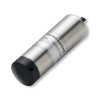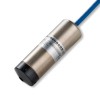A hydrostatic level probe typically uses pressure sensor to measure the water level. The main component of a pressure sensor is the sensing diaphragm which converts the difference in pressure between either side of the diaphragm into a measured signal.
The front of the diaphragm measures the water level pressure (hydrostatic pressure) plus the barometric air pressure pushing down on the water.
Vented Level Measurement Device
In a vented design the back of the diaphragm is exposed to the same barometric air pressure so that it will self-compensate for barometric changes.
- Pressure on front of diaphragm = Water Depth + Air
- Pressure on back of diaphragm = Air
- Actual Measured Pressure = Water Depth
This is the most common way to measure water level with a pressure sensor. There is no need to measure barometric pressure with a device that has a vented pressure reference, which simplifies the installation and reduces the cost because there is less instrumentation required.
Also this method is more accurate because the accuracy of only one sensor is considered, rather than the combination of two measurement devices.
Featured vented reference liquid level measurement products
 HVO and FAME biofuel storage tank submersible level sensor - Explore a solution for reliably measuring the level of biodiesel fuels such as HVO and FAME. A submersible level transmitter was specified with carefully selected wetted parts, including an FEP cable and FKM seals, to ensure long-term chemical compatibility in alternative fuel storage tanks.
HVO and FAME biofuel storage tank submersible level sensor - Explore a solution for reliably measuring the level of biodiesel fuels such as HVO and FAME. A submersible level transmitter was specified with carefully selected wetted parts, including an FEP cable and FKM seals, to ensure long-term chemical compatibility in alternative fuel storage tanks. High temperature de-ionised water bath 300mm ATEX level sensor - Level sensor for high temperature liquids up to 125°C, ATEX approved intrinsically safe 4-20mA output and a low range to measure 0 to 300 millimetres.
High temperature de-ionised water bath 300mm ATEX level sensor - Level sensor for high temperature liquids up to 125°C, ATEX approved intrinsically safe 4-20mA output and a low range to measure 0 to 300 millimetres.
Non-Vented Level Measurement Device
- Pressure on front of diaphragm = Water Depth + Air
- Pressure on back of diaphragm = Vacuum
- Actual Measured Pressure = Water Depth + Air
This method is used less than the vented reference type, but it does have advantages for some applications.
It is not always straightforward to provide a vent path, since the cable maybe terminated underwater, or the air at the surface maybe different to barometric reference pressure.
Vented cables can be problematic if not adequately protected from moisture and humidity, causing calibration shifts, unstable readings and in some cases failure of the sensor.
Featured non-vented reference liquid level measurement products
 Hydrophone array submersible 200 meter seawater depth sensor - Submersible pressure sensor which can be connected at the end of our hydrophone cable to measure the water depth.
Hydrophone array submersible 200 meter seawater depth sensor - Submersible pressure sensor which can be connected at the end of our hydrophone cable to measure the water depth. IMSL IP68 Stainless Steel 316L Hydrostatic Pressure Sensor - Water resistant pressure sensor for measuring hydrostatic pressures in the range of 0-0.5 mWC up to 0-100 mWC.
IMSL IP68 Stainless Steel 316L Hydrostatic Pressure Sensor - Water resistant pressure sensor for measuring hydrostatic pressures in the range of 0-0.5 mWC up to 0-100 mWC.
Help
Plugging the vent line
Can a vented transducer be converted to an absolute transducer simply by plugging the vent line?
An absolute transducer has a vacuum reference, by plugging the vent line you will instead be trapping in atmospheric pressure, which is called a sealed gauge reference.
You can still use this, but bear in mind that the trapped air pressure will vary if the temperature changes.
Also as the atmospheric pressure changes, so will the level/depth readings by the same amount of pressure change.
These effects on readings will be proportionally greater the lower the pressure range of the device.
Non-vented sensor in ditches & springs
Should we use a non-vented water level sensor in ditches and springs?
We would recommend a vented rather than a non-vented because it allows the sensor to self compensate for changes in barometric pressure. This is particularly important when measuring water level in ditches and springs where the water is much shallower, since the changes in barometric pressure will have a greater impact on the water level reading accuracy if they are not compensated for.
Also the range will need to be much greater for a non-vented type, e.g. a vented (gauge) 3.5 mH2O water level range would need to be a 13.5 mH2O for a non-vented (absolute) range, so the accuracy will be degraded by 4 times before you have even considered the errors associated with barometric changes.
Featured water level measurement products
 Water Level Transmitters with 4-20mA Output - Browse for 4-20mA water level transmitters using two-wire loop power. Ideal for wells, tanks, rivers & reservoirs with excellent noise immunity & long cable runs.
Water Level Transmitters with 4-20mA Output - Browse for 4-20mA water level transmitters using two-wire loop power. Ideal for wells, tanks, rivers & reservoirs with excellent noise immunity & long cable runs. 18.605 G Low Cost Submersible Diesel Fuel and Water Tank Level Sensor - Low cost OEM diesel fuel or water level sensor for installing inside or outside a storage tank.
18.605 G Low Cost Submersible Diesel Fuel and Water Tank Level Sensor - Low cost OEM diesel fuel or water level sensor for installing inside or outside a storage tank.
Related Help Guides
- Determining water tank volume using hydrostatic pressure
- Problem with zero drift when installing submersible pressure sensor
Related Online Tools
- Fluid Depth, Density, Gravity, and Pressure Calculator
- Well Depth – Water Level Depth to Water Level Height Calculator
Related Application Questions and Answers
- Immersible water level sensor for 4 metre deep cold water storage tank
- Hydropower reservoir submersible hydrostatic level transmitter & indicator
- Above ground level potable water tank pressure level indicator
- Water tank level gauge transmitter with adjustable range
- Potable water underground 10ft dia storage tank temperature and level sensor
- Industrial dishwasher 0-1m 0-10Vdc water level sensor
- Water temperature depth sensor for cooling tower sump
- Ebb & Flow (Flood & Drain) Horticulture Hydroponic System 100mm Water Level Sensor
- Water well level monitoring in 3/4″ dia sounding tube to 300ft
Contact us about this Difference between vented and non-vented water level measurement page to request more information, or to discuss your application requirements.
